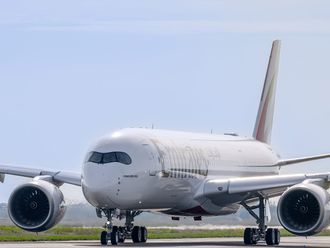
China’s currency, the renminbi, has been weakening in recent months, resurrecting familiar charges of manipulation, competitive devaluation, and beggar-thy-neighbour mercantilism.
In mid-April, the US Treasury expressed “particularly serious concerns” over this development, underscoring what has long been one of the most contentious economic-policy issues between the US and China.
This is a timeworn debate — politically inspired and grounded in bad economics — that does a serious disservice to both sides by diverting attention from far more important issues affecting the US-China economic relationship.
Taken to its extreme, America’s accusations risk pushing the world’s two largest economies down the slippery slope of trade frictions, protectionism, or something even worse.
First, the facts: Since hitting its high watermark on January 14, 2014, the renminbi has depreciated by 3.4 per cent relative to the US dollar through April 25. This follows a cumulative appreciation of 37 per cent since July 21, 2005, when China dropped its dollar peg and shifted its currency regime to a so-called “managed float.”
Relative to where it started nearly nine years ago, the renminbi is still up 32.5 per cent.
Over the same period, there has been a dramatic adjustment of China’s international balance-of-payments position. The current-account surplus — the most telling symptom of an undervalued currency — has narrowed from a record 10.1 per cent of GDP in 2007 to just 2.1 per cent in 2013.
The International Monetary Fund’s latest forecast suggests that the surplus will hold at around 2 per cent of GDP in 2014.
Seen against this background, US officials’ hand-wringing over the recent modest reversal in the renminbi’s exchange rate appears absurd. With China’s external position much closer to balance, there is good reason to argue that the renminbi, having appreciated by nearly one-third since mid-2005, is now within a reasonable proximity of “fair value”.
The IMF conceded as much in its latest in-depth review of the Chinese economy, which calls the renminbi “moderately undervalued” by 5-10 per cent. This stands in contrast to its earlier assessments of “substantial” undervaluation.
America’s fixation on the renminbi is a classic case of political denial. With US workers remaining under intense pressure in terms of both job security and real wages, politicians have understandably been put on the spot.
In response, they have fixated on the Chinese component of a long-gaping trade deficit, charging that currency manipulation is the culprit to the long festering woes of the American middle-class.
This argument is politically expedient — but wrong. The US trade deficit is a multilateral imbalance with many countries — 102 in all — not a bilateral problem with China. It arises not from the alleged manipulation of the renminbi, but from the simple fact that America does not save.
Lacking in domestic savings and wanting to grow, the US must import surplus savings from abroad, and run massive current-account deficits to attract the foreign capital. And that leads to America’s multilateral trade imbalance.
Yes, trade with China is the largest component of this imbalance, but that la largely reflects the complexity of multinational supply chains and the benefits of offshore efficiency solutions.
That brings us to the uncomfortable truth about America’s politically inspired China bashing: It will backfire. If America fails to solve its saving problem — a reasonable scenario in light of fiscal gridlock and persistently subpar personal saving — the current-account deficit will persist. That means that any reductions in China’s share of America’s external imbalance would simply be shifted to other foreign producers.
Significantly, this alternative sourcing will most likely have a higher cost base than Chinese production, thereby imposing the functional equivalent of a tax hike on already-beleaguered middle-class Americans.
As China rebalances toward a growth model that draws greater support from domestic demand, Washington should stop ranting about the renminbi and start focusing on the opportunities that this bonanza will create. That means emphasising US companies’ access to China’s domestic goods and services markets.
Pushing for a bilateral investment treaty that relaxes caps on foreign ownership in both countries would be an important step in that direction.
Similarly, the US needs to give China credit for having taken meaningful steps on the road to further currency reform. The mid-March widening of the daily renminbi-dollar trading bands to plus or minus 2 per cent (from the earlier 1 per cent band) is an important step in relaxing control over the so-called managed float.
That, coupled with the 3 per cent depreciation in the past few months, should send a strong signal to speculators that one-way renminbi bets are hazardous — a signal that could help dampen inflows of hot money, which have complicated liquidity management and fuelled asset-market volatility in China.
There are two views of the future of the US-China economic relationship: one that sees only risk, and another that sees opportunity. Fixating on the renminbi falls into the former category: It misses the rebalancing and reforms already under way in China and deflects America’s focus from addressing its most serious long-term macroeconomic problem — a lack of saving.
By contrast, viewing China as an opportunity underscores the need for America to undertake its own rebalancing — rebuilding US competitiveness and pushing for a meaningful share of China’s coming boom in domestic demand. Unfortunately, the revival in US saving that this will require is being drowned out by the renminbi rant.
— Project Syndicate, 2014
CREDIT: The writer is a faculty member at Yale University and former chairman of Morgan Stanley Asia.











